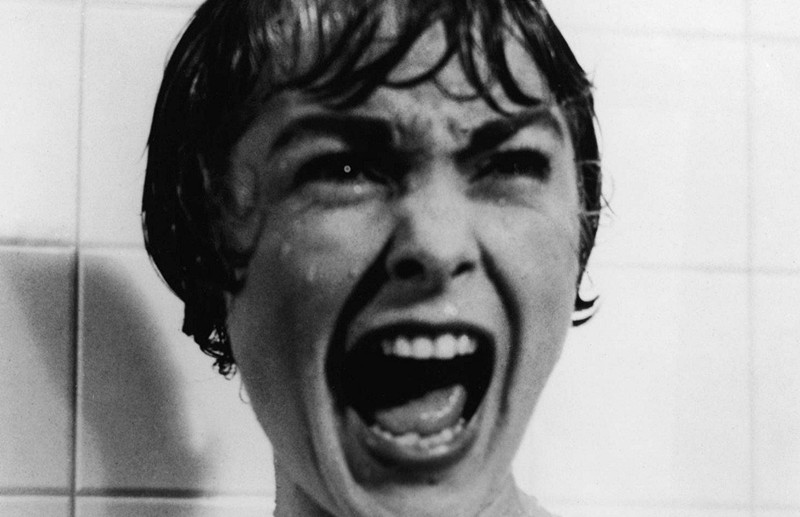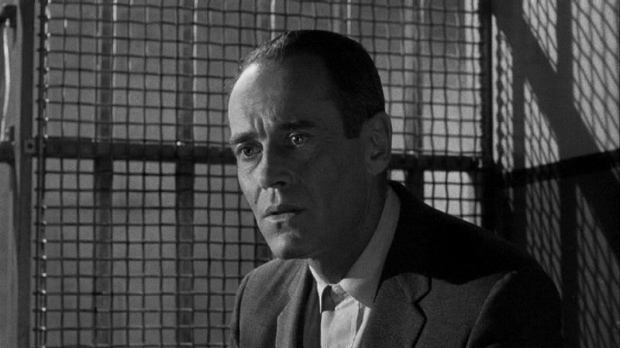It goes without saying that Alfred Hitchcock is one of the greatest directors in the history of cinema. Known as the Master of Suspense, Hitchcock had a special touch to each of his pictures that made him stand out as a director. This list represents the techniques and methods he used that made his movies stand out. It’s these little details that stood the test of time and helped creating the tension and suspense he was aiming to bring to an audience.
10. The Dolly Zoom from “Vertigo”
It was impossible not to include this on the list. it ranks low here because sadly this technique has become overused and abused by filmmakers for years after “Vertigo” was released. I’m one of those filmmakers that are guilty as charged. It’s been called the “Zolly”, “Jaws shot” and “reverse tracking shot”, but its origins begin in this Hitchcock masterpiece.
Developed by Paramount Pictures second unit cameraman Irmin Roberts, the Dolly Zoom was used by Hitchcock in the famous scene of James Stewart climbing up the stairs. His character suffers from vertigo after a traumatic episode he faced in his life. As he climbs higher, he looks down and sees how high up he is and we get the point of view shot that gives us the illusion of what he’s feeling and seeing. It really brings you in and you get that feeling of too high as the camera zooms out and dollies in at the same time or vice versa.
For years after the movie came out, directors started implementing it into their own films such as Spielberg for “Jaws”, Scorsese for “GoodFellas”, Landis for Michael Jackson’s “Thriller”, etc. It has become almost a cliché in this day and age, but it’s still as affective as ever in “Vertigo”.
9. The Intro to “Strangers on a Train”
This may not be a big deal to many, but this opening has some layers to it that is quite interesting.
The film tells the story of a socialite who meets a tennis player on a train and shares with him a plan for a perfect murder and get away with it. What I like about this sequence is how we don’t see their faces, but only from the knees down. We identify that these are two different men by their shoes and which direction each one comes from. They continue that way until they bump into each other at the end of the scene. This is when they meet and the story commences.
This is a simple but brilliant way on Hitchcock’s part to connect these two characters together through the use of camera work and editing. These two complete strangers are slowly coming together and the audience is in on it.
8. The Milk in “Suspicion”
“Suspicion” tells the story of a woman who suspects her husband is trying to kill her. There’s one scene in the film that really jumped out.
That’s the scene where Joan Fontaine’s character is in bed, fearing the worse and her husband, played by Cary Grant, brings her a glass of milk. The camera follows Cary Grant coming up the stairs and as he continues something strange stands out about the glass of milk. It’s bright and bold in the frame. Is he trying to poison her? That’s certainly what we thought when we first it.
That was Hitchcock’s intention, actually. He put a light in the glass to highlight it in the shot to get the audience to wonder what was going to happen next. It’s a simple, but ingenious, technique.
7. Whirling Camera in “The Wrong Man”
For some reason, “The Wrong Man” is always under the radar. The film features a common Hitchcock theme about a man wrongly accused. Henry Fonda plays a man who has a striking resemblance to a murderer. When the man is wrongfully thrown in jail for the murder he didn’t commit, Hitchcock again helps the audience get in the head of the character with his camera work.
When Fonda realizes there’s nothing he can do at this point to prove his innocence, he puts his head back against the jail cell wall and the camera whirls around and around, picking up speed. It successfully gives this disorienting affect of feeling lost.
6. Use of Double Exposure in “The Wrong Man”
Again, “The Wrong Man”. This time, though, we have a scene where Henry Fonda’s character is at an all time low at this point in the story. His innocence still hasn’t been proven. So, he prays to the Lord for hope. As he does so, the picture dissolves into a close up of the murderer and both of their faces line up with each other.
Again, this scene presents a lot of layers to the story. These two men live in two different worlds and what Hitchcock does is show these two worlds colliding witch each other.

